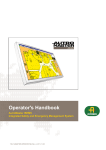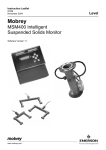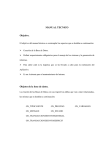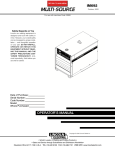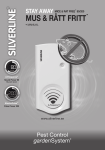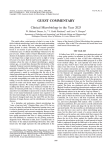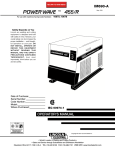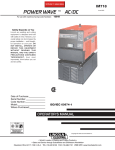Download Emerson IP221/SI s Unit installation
Transcript
Instructions Leaflet IP221, Rev. AA November 2004 Level Mobrey Electropulse systems Contents Safety Information 1. Introduction 1.1 Sensors Gap Sensors Hi-Sens 2 1.2 Interface detection Attenuation method Reflection method 4 1.3 Sludge density detection 5 1.4 Head amplifier units Normallay acting Inverse acting Summary 5 1.5 Control Units 6 2. Installation 2.1 Calibration 2.2 Sensor and head amplifier installation 2.3 Control Unit Installation 2.4 Wiring Cables Head amplifier Control Unit 2.5 Intrinsically safe application 3 7 10 12 12 15 3. Fault Finding 16 4. Specification and description 4.1 Sensors 4.2 Head amplifiers 4.3 Control Units 17 17 18 5. Recommended Spare Parts For instructions specific to units used in hazardous area installations refer to leaflet IP221/SI Appendices Appendix I Appendix II Appendix III Part Numbers List of illustrations List of tables Maintenance / Inspection www.mobrey.com 1 20 22 22 23 Warning : If this equipment is used in a manner not specified by the manufacturer, the protection provided may be impaired. All installation and commissioning of this equipment must be carried out by electrically competent persons. Protection of permanently installed equipment : This equipment is regarded as permanently installed equipment. Ensure wiring is suitable for the load current and the insulation is suitable for the voltage, temperature and environment of the installation. A supply disconnection device must be included in the installation, fitted as close as practical to and not be obstructed by the equipment. It must be double pole and marked as the disconnection device. Each relay circuit must be protected by a fuse not exceeding the maximum rated current for the relay as specified in the manual. On wall mount unit disconnect supply before removing control unit from base. Control units must be correctly assembled to achive stated IP ratings. Explanation of symbols : The IEC symbols used on the equipment are as follows : ! Refer to Manual. The Protective earth terminal must be connrected to an external Protective earthing system. Functional earth terminal. |f this terminal is used it must be connected to an external earthing system at the same potential as the protecive earthing system. 2 1. Introduction The Mobrey Electropulse system is used for the detection of liquids or liquids with suspended / settled solids. It consists of three units, a sensor, a head amplifier unit, and a control room unit. 1.1 Sensors There are many different Mobrey sensors available, but they fall into two categories: a) Gap sensors Figure 1.1 - Gap sensor, cut away to show construction Gap sensors feature two ultrasonic transducers mounted one either side of the gap. When immersed in a liquid the signal transmitted is carried by the liquid across the gap, to the receiver, when the liquid level drops below the sensor, the signal cannot be carried across the gap, and is not received by the second transducer. b) Hi-Sens cylindrical sensors The Hi-Sens sensor consists of two ultrasonic transducers mounted on the inside of a cylinder. When the sensor is not submersed in the liquid the signal from one transducer resonates round the cylinder like a bell ringing. If the liquid rises up around the sensor, this ringing is damped and the signal received by the second transducer is significantly reduced. This reduction is monitored by the head amplifier unit. Switching occurs when the liquid is about half way up the cylinder. Use of Hi-Sens transducers in high alarm applications, and gap sensors in low level alarm applications achieves a Failsafe system in which any sensor or cable failure will be indicated as a fault or an alarm by the control unit. Figure 1.2 - Hi-Sens, cutaway to show construction 3 1.2 Interface detection Attenuation method – Figure 1.3 Attenuation is the reduction in strength of the ultrasonic signal caused by its transmission through a liquid. Viscous liquids, emulsions and liquids containing solid particles have a greater attenuation than clear thin liquids. Usually the difference in attenuation between the two liquids is sufficient and the attenuation method can be used to determine which liquid is in the sensor gap. In this case the gain of the control unit is set so that the relay is energised only when the liquid with the lower attenuation is in the gap. For this application Sensor Type 402S is used horizontally. The heavy-duty sensor type 433S may also be used, perhaps from above on an extension tube. For use in pipes, the sensor pair 442S should be mounted in line, facing one another, generally horizontally across the diameter, to detect the interface or presence of liquid. As an example, the interface between oil and water can be detected using this method. OIL Transmitter Crystal Receiver Crystal Sensor in Oil. The ultrasonic beam is attenuated and will not reach the receiver crystal. Figure 1.3 - Attenuation Method WATER Receiver Crystal Transmitter Crystal Sensor in Water. The ultrasonic beam reaches the receiver crystal. Reflection Method – Figure 1.4 If the attenuation’s are similar and the attenuation method does not work, then the reflection method must be used. If an ultrasonic beam is transmitted from one liquid to another at a suitable angle, it does not go straight through the interface, but is bent, so that it does not reach the receiver crystal. If there is no interface in the gap, but only one liquid, then the beam travels in a straight line, is received and the relay energised. For this application the sensor must be mounted at about 10º from the horizontal, as shown in Figure 1.4. Note that this method gives an alarm only when the reflective surface of the interface itself is at the sensor. Oil Water Sensor in lower liquid. The ultrasonic beam reaches the receiver crystal. Figure 1.4 Oil Water Receiver Crystal Transmitter Crystal Sensor at interface level. The ultrasonic beam is reflected/refracted and will not reach the receiver crystal. In order to differentiate between two liquids, interface sensors have a large gap (usually 150mm) and oscillate at 3.75MHz. 4 1.3 Solids Density Detection The Electropulse system can be used in conjunction with a 433S type sensor to provide blanket level detection in settling tanks, facilitating the control of automatic de-sludging. In addition the Electropulse system can be used to detect the solids density of a slurry in a pipe line. In this case the Mobrey pipe section is used instead of the sensor. Figure 1.5 - Sludge density sensor, operation (a) Clear liquid, signal transmitted (b) Solids attenuate the signal Figure 1.5 shows the operation of the sensor. In a clear liquid the ultrasonic signal is carried across the gap so the sensor oscillates and the control unit gives a ‘Normal’ indication. When a sludge is present this scatters the signal as shown in Figure 1.5(b) The signal is attenuated, and the control unit gives an alarm indication. 1.4 Head Amplifier Units The head amplifier is mounted on the end of, or near to the sensor. It converts the low level high frequency signal of the sensor into a series of low frequency current pulses that are sent to the control unit. These pulses are virtually immune to electrical interference. This means that the length of the cable between the head amplifier and the control room can be 1km or more. There are five versions available, which fall into two categories: i) Normal acting head amplifiers When the sensor is in its normal state (i.e. Dry for Hi-Sens and Wet for Gap Sensors) the signal from the transmitting transducer is received by the second transducer, and fed back to the head amplifier causing it to transmit current pulses to the control unit. If an alarm state occurs the sensor no longer oscillates, and the head amplifier stops transmitting the pulses. The control unit indicates the alarm condition. Thus in the normal state, the whole system is active. If a fault occurs in the electronics then the pulses cease and an alarm state is indicated immediately. In this way the whole circuit is continually monitored. This is in addition to the fault checking facilities of the control unit. There are four versions of the normally acting head amplifier. Usually it is possible to mount the head amplifier on the sensor, but it may be necessary for reasons of temperature or space, to use a head amplifier which is mounted adjacent to the sensor, and is connected to it by a short length of coaxial cable. Both of these types are available either in an industrial case, or a heavy-duty case that is suitable for open deck mounting in marine applications. The sensor mounted marine head amplifier may contain a double circuit board for use with dual HiSens or gap sensors. 5 ii) Inverse acting head amplifiers When it is required to use a Hi-Sens sensor for low level detection, or a Gap Sensor for high level detection, an inverse acting amplifier must be used. Examples of this are given below: • Hi-Sens can be used to detect low levels in very light liquids or foams. • A miniature Gap Sensor 366S, may be used to detect high level when there is insufficient room for a Hi-Sens. • High temperature, corrosive, or aerated liquids, where Gap Sensor can be used at high level if required. The head amplifier transmits pulses when the sensor is not oscillating (its normal state), and stops transmitting in the alarm condition when the sensor is oscillating. Thus the normal light on the control unit indicates a wet Hi-Sens, or dry gap sensors. When the inverting amplifier is used the sensor is in its quiescent state for most of the time. For this reason sensor cables can be monitored to check for cable breaks with some sensors. Note that when an inverse acting head amplifier is used the sensor is not oscillating under normal conditions and therefore the integrity is not as high as that of a normally acting head amplifier, which should be used wherever possible. Inverse acting amplifiers are only available in adjacent mounting industrial housings. Summary of sensor head amplifiers 1.1 Type Sensor mounting Adjacent mounting Inverse acting 1.2 Sensor State Hi-Sens Dry Lo-Sens Hi-Sens Wet Wet Lo-Sens Dry Industrial Case ***S*PI*** MEP*AI MEP*XI Marine ***S*PM*** - Output Normally acting head amplifier *PI*, *PM*, AI Normal State Pulses transmitted Green light on c.u. Alarm State No Pulses transmitted Red light on c.u. Inverse acting head amplifier XI Alarm State No Pulse transmitted Red light on c.u. Normal state Pulses transmitted Green light on c.u. Sensor cable check circuitry is built into the industrial adjacent mounted head amplifiers, where the coaxial cable linking head amplifier and sensor may be exposed on site. This is only operable where the sensor in use has Earth continuity between the two coaxial cables, see section 2.2 Lack of screen continuity along these cables causes the head amplifier to signal a fault condition to the control room readout unit. To use the facility a wire link in the head amplifier must be cut during installation. (See section 2.2) 1.5 Control Units The control unit is available in two forms, a free standing plastic case (MEP*L), or a rack mounting unit (MEP*R). Operation is the same in either case. Front panel indicators show normal condition (green), alarm (red), and fault (amber). A front panel switch to test fault and alarm circuits is provided, together with a variable time delay for the alarm circuit. Relay contacts are provided to indicate an alarm condition. A second relay is supplied on rack mounting control units to indicate a fault. On both units, a fault also causes an alarm to be indicated. 6 2. Installation 2.1 Calibration When installing the sensor, it should be remembered that it is measuring instrument, and should be treated with care. Before installation the sensor and control unit should be inspected for transit damage, the gap faces of gap sensors must be parallel. Before installation, the equipment should be calibrated, if possible, using a representative sample of the liquid in which it is to be used. The head amplifier unit should be wired to the control unit, which should be connected to its power supply. Wiring instructions are given in section 2.4. When the mains supply to the control unit is switched on, either the green ‘normal’ light or the red ‘alarm’ light should be on, the amber ‘fault’ light should be off. The lid of the head amplifier unit is removed by undoing the four screws or Allen bolts. Care should be taken not to damage the sealing gasket, which should be replaced with the lid. When using integral head amplifiers, the sensor must not be unscrewed from the head amplifier unit as this is likely to damage the internal wiring (and may violate ATEX approval). i) ***S*PI ii) ***S*PM Figure 2.1 - Head amplifier internals iii) MEP*AI and MEP*XI The marine head amplifier ***S*PM has one gain potentiometer for each sensor attached. It is factory calibrated for the side range of liquids carried on tankers. It is advisable to check the function of the system before final installation, using a sample of the liquid. The gain potentiometers are covered by a screw cap, which should be replaced after re-calibration. The industrial head amplifiers ***S*PI, MEP*AI and MEP*XI have a gain switch, which is illustrated in Figure 2.2 (i) and 2.2 (iii). 7 Calibration procedure by sensor type i) Hi-Sens Sensors 1) Ensure that the sensor is clean and dry, that nothing is touching the sensor body, and that the delay adjustment on the control unit is fully anti-clockwise. 2) Set the gain potentiometer in the head amplifier fully anti-clockwise, and the gain switch (if fitted) in the low gain position. 3) The control unit should now indicate ‘alarm’ (or ‘normal’ for inverse acting head amplifiers). 4) Gradually increase the gain until the control unit indicates ‘normal’ (or ‘alarm’ for inverse acting control units). This is beginning of the operating band. 5) The optimum gain setting can be found by rotating the potentiometer a further 30º (one division on the clock face), 6) Check that the control unit switches satisfactorily when the sensor is immersed in the liquid. ii) Gap Sensors 1) Ensure that the sensor is clean, and immerse it in a sample of the liquid, making sure that the gap is full of the liquid, and unobstructed. Adjust the time delay on the control unit fully anticlockwise. 2) Set the head amplifier gain control fully anti-clockwise, with the gain switch (if fitted) in the high gain position. 3) The control unit should now indicate alarm (or normal for inverse acting head amplifiers) if it does not switch to low gain (if a gain switch is fitted). 4) Gradually increase the gain until the control unit indicates normal (or alarm for inverse acting head amplifiers). Note the position of the potentiometer and gain switch. This is the lower end of the working range. 5) Remove the sensor from the liquid, and allow the liquid to drain away. Ensure that nothing is touching the sensor body. The control unit should now indicate alarm (or normal for inverse acting head amplifiers). 6) Gradually increase the gain until the control unit indicates normal (or alarm for inverse acting head amplifiers). Note the position of the potentiometer and gain switch. This is the upper limit of the working range. 7) The optimum gain setting is midway between the points recorded in steps 4 and 6. It may be necessary to estimate this point if the gain switch has been used. 8) Check that the control unit switches correctly when the sensor is immersed in the liquid. iii) Interface Sensors – Attenuation Method 1) Ensure that the sensor is clean, and that the delay on the control unit is fully anti-clockwise. 2) With the sensor in the lower liquid adjust the gain potentiometer anti-clockwise, using the gain switch if necessary, until the control unit changes from ‘Normal’ to ‘Alarm’. 3) Note the position of the potentiometer. If the control unit does not switch to ‘Alarm’ use the bottom end of the scale as a reference. 4) Immerse the sensor in the upper liquid. The control unit should now indicate ‘Alarm’. If it does not then the reflection method should be used. 8 5) With the sensor in the upper liquid, increase the gain, using the switch if necessary, until the control unit changes to ‘Normal’. Note the position of the potentiometer. If the control unit does not change to normal then the end of the scale should be used as a reference. 6) The gain should be set half way between the settings found in steps 3 and 5. 7) Check that the unit switches correctly giving a normal indication in the lower liquid and an alarm indication in the upper liquid. 8) If an inverse acting head amplifier is used, ‘Normal’ and ‘Alarm’ conditions quoted above are reversed. iv) Interface Sensors – Reflection Method 1) Check that the sensor is clean and that the control unit delay is fully anti-clockwise. 2) Immerse the sensor in each liquid in turn, adjusting the gain potentiometer until the control unit changes from ‘Alarm’ to ‘Normal’. Note the position at which this occurs for both liquids. If the two positions differ by more than two divisions, the attenuation method can be used. 3) For the reflection method, the gain should be set one division greater than the higher of the two settings found in step 2. 4) This gives a rough calibration. The gain should be increased if spurious alarms cannot be overcome by increasing the delay. The gain should be decreased if the unit fails to detect interfaces. 5) For the reflection method the sensor should be mounted at an angle of 10º to the horizontal. 6) Where the interface consists of an emulsion layer, the sensor functions as the reflection method, giving an ‘Alarm’ condition only at the interface, but in this case, it is not necessary to angle the sensor at 10º. 7) If an inverse acting head amplifier is used, ‘Normal’ and ‘Alarm’ conditions quoted above are reversed. v) Sludge Sensor 1) Ensure that the control unit delay is set fully anti-clockwise. 2) When used with a 433S type sensor, the sensor should be positioned at the top of the sludge blanket during calibration. 3) The gain can now be adjusted until the control unit changes state with the sensor in this position. 4) Check that raising and lowering the sensor into and out of the sludge blanket causes the control unit to switch. 5) If the pipe section is used, the tank should be de-sludged until the pipe contains solids at roughly the required switching point. The gain is then adjusted until the unit just switches. This should only be done when the slurry in the pipe is flowing. 6) The pipe section should be installed with the sensors in a horizontal plane, and with 10 diameters of straight unrestricted pipe upstream and six diameters downstream. 9 2.2 Sensor and head amplifier installation Make sure that there is room inside the tank for the sensor without anything touching it, and that the gap is not obstructed. At least an inch of clearance must be left around Hi-Sens senors. The head amplifier should have its cable glands downwards if possible to reduce the possible to reduce the possibility of ingress of rainwater. For threaded sensors a hole is drilled in the tank at the appropriate level, and this is tapped to take the sensor. On thin walled tanks it may be necessary to fit a boss to the tank. Use PTFE tape or similar to seal the thread so that the sensor does not have to be over-tight for a good seal, as this may damage the sensor. The sensor should be screwed in using a spanner on the hexagonal fitting, not by turning the sensor head unit. It is assumed that the sensor will be earthed through the tank. For flanged sensors, arrange a suitable counter flange, and fit using a gasket, tightening the bolts evenly. If possible the bridge of sensors 302S and 402S should be to the side of the gap, and not above or below it, and all gap sensors should have their gaps vertical. This is so that any sludge in the tank cannot settle on the faces of the sensor. Interface probes 402S and 433S may be mounted at an angle of 10º to the horizontal so that they can be used in either attenuation or reflection mode. Mounting details for the adjacent head amplifier are shown in Figure 2.3. Both model types MEP*AI and MEP*XI adjacent mounted amplifiers have a sensor cable continuity check system built in. This cable check is only operative when one of the following sensors is in use. 30HS, 302S, 312S, 312SP, 323S, 352S, 362S, 373S, 393S, 402S, 433S 24.0 56.0 The cable check circuit is activated by breaking Link 3, positioned next to the A & B terminals. (See Figure 2.1) 4 FIXING HOLES Ø 4.5mm 120.0 15.0 90.0 OF FIXING HOLES 110.0 OF FIXING HOLES 25.0 122.0 Figure 2.2 - Adjacent head amplifier mounting details 44.0 32.0 10 * DIN RAIL Mounting Clip available on request Figure 2.3 - Control unit mounting details 11 2.3 Control unit installation The control units should be installed in an area suitable to their specifications. They are designed to be used indoors, but could be installed outside using a suitable weatherproof enclosure. The front panel should be accessible to the operator. The standard control unit MEP*L is installed by undoing the two screws on the top and bottom of the unit, and removing the base. This can now be mounted as required, making sure that the connection terminals are on the left-hand side of the base. The 19” rack unit should be mounted in a suitable cabinet in the usual fashion. It accepts up to fourteen rack modules to type MEP*R. It should be noted that I.S. control units MEP3R will only fit into an I.S. rack MEP3B and that the rack is included in the approval. Mounting details are shown on the previous page. Allow at least a 50mm gap between each rack on multiple rack installations to allow air circulation. On installations of multi-rack systems, the fitting of a cabinet air circulating fan is recommended. Wires to the MEP*B rack units are connected to the terminal blocks mounted on the rear panel of the rack. In the factory the modules are fitted starting from the left hand side when viewed from the front of the rack. If desirable, the connectors and modules can be repositioned in the rack. To assist with cable wiring, the connector block wire access faces the rear of the rack and the screw terminals are therefore angled. To fit cable to the 5 modules closest to the right hand end of the rack (numbers 1014) it is necessary to release the connector and rotate it slightly to allow screwdriver access. 2.4 Wiring i) Cable The connection from amplifier to the control unit should be made with two-core twisted pair instrument cable with overall screen. The cores should be at least 0.5mm2 and the cable length not more than 1 km, the screen may be omitted on cable runs of 10m or less, provided that the installation will not be subject to excessive electrical noise. A summary of wiring arrangements is shown in figure 2.4. Please consult the factory if this specification does not cover your needs, and for recommended cables. Sensor Control unit Head amplifier N.B. Relays are shown in their ‘normal’ operating states Supply Do not connect screen Protective earth Alarm relay 35m *Max (cable supplied with sensor) MEP*A* and MEP*X* only Fault relay (MEP*R only) 1km max. N.B. Control unit contacts may not be in the order illustrated Connect screen at this end only * 15 max on i.s. systems Cores Min. area 0.5mm2 Max loop Impedance 35Ω SECTION THROUGH CABLE Outer Sheath Screen Inner Sheaths Refer to section 2.5 for I.S. requirements Figure 2.4 - Wiring summary for illustration only 12 ii) Head Amplifier Unit The head amplifier terminals A+ and B- should be connected to the cores of the control unit cable. In the case of the dual marine unit, lower sensor connections A+ and B- are connected to the two cores of one cable, and upper sensor connections, C- and D+ to the other. The screen should not be connected in any head amplifier unit, as this could cause an earth loop. The marine head amplifier has cable grips which should be used. Care should be taken not to overtighten these, as this could result in damage to the circuit board. The cable is then taken out through the cable entry in the head amplifier. When an adjacent head amplifier (AI or XI) is used, the sensor cable pins 1 and 2 are connected to terminals 1 and 2 respectively in the sensor head amplifier. The green earth wires are connected to the ‘E’ terminals, as shown below. Red wire with No 1 tag to 1 green wire to E . Red wire with No. 2 tag to 2 green wire to E To sensor Figure 2.5 iii) Control unit The system is designed to be noise immune; however, it is good practice to separate the instrumentation cables from power cables. Figure 2.6 shows the terminal arrangements. The head amplifier cable cores are connected to the + and – terminals on the control unit, ensuring that +A and +D is connected to the + terminal, and –B or –C respectively is connected to the – terminal. The screen is connected to the “SCN” terminal marked sensor on the rack-mounted unit. The main connections are made to the L and N terminals of the control unit. The control unit must be earthed, this is mandatory on intrinsically safe units. The free standing control unit has one relay, which is a double pole changeover (DPCO) relay. This relay is normally energised and will release if an alarm or fault condition occurs. The rack-mounting unit has a single pole changeover (SPCO) fault relay, and an SPCO or DPCO alarm relay. The alarm relay is normally energised and releases if an alarm or fault condition occurs. The fault relay energises if a fault occurs. Thus in ‘normal’ mode with the green light on, the alarm relay is energised, and the fault relay is not, as shown in Figure 2.4. An HBC fuse should be included in the relay circuit as specified in Table 2.1. All fuses are 20mm x 5mm Control Unit Relay Relay contact rating (each) Maximum fuse rating at 240V at 120V MEP3R/*D DPCO 45VA 400mA 200mA MEP3R/*S SPCO 500VA 4A 2A MEP3L/*D DPCO 500VA 4A 2A Table 2.1 - Relay Ratings 13 MEP 3B I.S. To head amplifier Screen to be connected Relays Protective Earth Neutral Live MEP 3L I.S. Figure 2.6 - Control Unit Connections 14 Supply 2.5 Intrinsically safe installation Control units type MEP3* and head amplifier units to type MEP3** and ***S*P*H** are approved by ATEX as intrinsically safe equipment to II 1 G Ex ia IIC. Refer to safety instruction IP221/SI and local code of practice. The following points must be noted when installing these units:i) The cable from the head amplifier to the control unit must be screened, and the screen must be connected at the control unit end only. ii) On I.S systems the cable from sensor to head amplifier must be less than 15 meters long. If more than 3 meter is required, special cable must be used. iii) The control unit must be earthed using at least 4mm2 wire. All screen earth and main earth connections must be commoned. In the case of the rack unit, MEP3B, the chassis must be earthed and each unit connected independently to the chassis earth. iv) I.S. cables must exit the control separately from the mains and relay cables. v) It is the responsibility of the installer to ensure that local codes of practice are followed. Intrinsically Safe Electropulse is approved by ATEX & standards EN50014 and EN50020. The certificates are listed below: Description Certificates of Conformity Approval Code To Standard MEP3 L MEP3 R/MEP3 B II (1) G [EExia] IIC EN 50014 & EN 50020 Sensor & Head Amplifier II 1 G EExia IIC T4 EN 50014 & EN 50020 Adjacent Amplifier II 1 G EExia IIC T4 EN 50014 & EN 50020 Sensors (separate) II 1 G EExia IIC T4 EN 50014 & EN 50020 Table 2.2 - Approvals 15 3. Fault Finding If the unit does not work as described in the text, this section suggests some simple checks which will rectify most faults. If the system still ceases to work or there is any doubt as to its working, the factory should be consulted. IT SHOULD BE NOTED THAT SOME OF THE TESTS BELOW VIOLATE I.S. REQUIREMENTS AND SHOULD NOT BE ATTEMPTED ON I.S INSTALLATIONS. If in doubt please contact the factory. The first test is always to check the mains supply voltage. The correct supply voltage is written on the circuit board, and is easily checked. Connecting a unit to the wrong voltage will at best prevent it from working, and at worst cause irreparable damage. It is also useful if possible, to exchange the control unit for another which is known to be working, being careful to check that they both run at the same voltage. This is a simple matter as both types of control unit unplug from their connections. The following is a list of common faults and suggested remedies. Make sure when fault finding that the control units are connected to the correct head amplifier. Possible faults and suggested remedies: No front panel lights lit i) Check that mains is connected and switched on. ii) Check the fuse, and replace if necessary. The part numbers for fuses are: • All rack modules - H1525 (F 500mA HBC) • Free standing unit 240V - K1793 (T 63mA, 35A Breaking capacity) • Free standing unit 120V - K1796 (T 125mA, 35A Breaking capacity) All fuses are 5mm x 20mm IEC 127. Fault indicated i) Check for short circuits between the head amplifier cable cores, or open circuits. Disconnect the cable from the control unit, and measure the resistance between the two wires to the head amplifier. The resistance should be a little over 100K ohm in one direction, and about 3.5K ohms to 50k ohms in the other with the head amplifier connected depending on the meter used. Check that the resistance between either core and the screen is at least 2M ohm when the screen is disconnected at both ends. ii) Excessive current causes a fault alarm. The head amplifier usually consumes 12-16mA. This is measured by disconnecting one of the head amplifier terminals, and connecting a millammeter between the head amplifier terminal and the end of the wire. Reconnect the wire when this measurement has been taken. iii) Cable cores must be connected at both ends, and the screen must be connected at the control unit end only. iv) Make sure that the cable is within the specification of section 2.4 (i). v) Ensure that the link in the head amplifier has not been removed unless the unit is used with one of the sensors listed in Section 2.2 Unit not switching Recalibrate as described in Section 2.1. Relay contacts not changing i) If the lamps are indicating the correct status of the appropriate sensor, but the relay contacts at the rear of the unit are apparently not changing state, check the external fuses in the relay circuits. ii) Check that the relay inside the unit is switching freely. 16 4. Specification and Description 4.1 Sensors Sensor Type Minimum Temperature ºC Maximum Temperature ºC Maximum Pressure Kg/cm2 Fitting Frequency 302S 30HS 312S 312SP 323S 352S 362S 366S 373S 393S 39HS 402S 420S 433S 442S HL*S -70 0 -70 -70 -70 -70 -210 -210 -70 -70 0 -70 -70 -70 -70 -70 150 250 130 130 130 150 65 65 150 150 250 150 150 150 150 130 56 50 21 20 21 56 70 3.5 56 56 50 103 280 105 105 100 R¾” R1½” R1” R1” R¾” R¾” R¾” M6 R¾” R¾” R¾” R¾” ¾” NPT R¾” R¾” Flange or screw 1 1 1 1 1 1 3.75 3.75 1 1 1 3.75 3.75 1.20 3.75 1 * Note that 1 kg/cm2 = 100kPa Table 4.1 - Sensor specification 4.2 Head Amplifiers Power supply: Normal 11.5V, 12-16mA from the control unit Operating frequency: 1 or 3.7 MHz Gain: Potentiometer adjustable, switchable ranges on MEP**I Output: Current pulses transmitted to control unit in ‘Normal’ mode (270 Hz) Temperature Range: -25 to 85ºC Test Switches: Optional: MEP* AI, ***S*PI**, ***S*PM** simulates a break in the sensor cables (fault test) MEP*XI simulates active sensor, stopping pulses (alarm test) Housing: i) ***S*PI**: IP54 Aluminium housing, mounted on sensor, Pg 16 cable entries ii) ***S*PM**: IP68 Gunmetal or Stainless steel, mounted on sensor, M20 cable entries, holds up to two head amplifier circuits. iii) MEP*AI: IP65 Polycarbonate, mounted adjacent to sensor MEP*XI Cable: i) Head amplifier ii) Sensor to head Not supplied, see Section 2.4 (i) for specification. to control sensor MEP* (AI, XI) only, supplied with sensors. amplifier Earthing: Head amplifier must not be connected to the screen of the control unit cable. On adjacent amplifier, the screens of the sensor cables must be connected to the head amplifier. Intrinsic Safety: Units type MEP3 are intrinsically safe, see table 2.3 for certificate details 17 4.3 Control Units Supply: Rack Mounted Unit MEP*R Free Standing Unit MEP*L 1: 220/240V ±10%, 50/60Hz 2: 110/120V ±10%, 50/60Hz Power consumption: Less than 7VA Output: Alarm relay DPCO relay, energised in normal mode, releases on fault or alarm Connections: Terminal block on the rear of the Screw terminal in the base of the rack unit. case. To take wires up to 1.5mm2 See Figure 2.7 for wiring details Earthing: Mains input and sensor connections are fully floating with respect to earth. The earth terminal on the freestanding unit and the rack must be earthed. Intrinsic safety: Output to Head Amplifier: Temperature Range: Housing: Less than 6VA Fault relay: SPCO, Energises in fault mode Alarm relay: High current SPCO, Low current DPCO, Energised in normal mode releases on fault or alarm See Table 2.1 for relay ratings Units MEP*L and MEP*R are intrinsically safe. See table 2.2 for certificate details. Approximately 11.5V 20mA maximum -10ºC to 65ºC The units must be left to warm up for 15 minutes before being exposed to sub-zero temperatures. IP20 enclosure. Optional DIN rail mounting or wall mounting. Maximum altitude : 2000m Maximum humidity : 95% Environment: Installation Category: 19” rack unit to hold up to 14 controls. CAT II (264V a.c. MAX) Pollution 2 CAT III (132V a.c. MAX) Pollution 2 3 LEDs Green = Normal Red = Alarm Amber = Fault Indicators: At least one LED should be on at any time. Fault Indication: A fault is indicated if too much, or too little current is taken by the head amplifier, indicating a short circuit or an open circuit. Alarm relay de-energises Test Switch: Alarm Delay: Reset: E.M.C. L.V.D. Alarm relay de-energises Fault relay energises a) Test Alarm Simulates the alarm condition by stopping the pulses. Alarm relay de-energises Alarm relay de-energises b) Test Fault simulates a short circuit in the cable between control room and the head amplifier, fault and alarm is indicated. Alarm relay de-energises Alarm relay de-energises Fault relay energises 1-10 seconds. Preset on front panel (20 turns span) Returns to normal approx. 200ms after alarm is cleared. BS EN61326: 1998 (Emissions) for Class B Equipment BSEN61326: 1998 (Immunity) for continuous unmonitored operation in industrial locations EN61010-1 18 5. Recommended Spare Parts 5.1 Sensor and head amplifier Sensors and head amplifiers are supplied as integral items, and therefore no spare parts are available. In the case of sensor mounted head amplifiers, the sensor is attached to the head amplifier, and the two are not usually available separately. 5.2 Control Units i) Fuses Standard Control Unit: MEP*L/1* (220/240V) MEP*L/2* (110/120V) K179 T 63mA, 35A Breaking capacity (IEC 127) K1796 T 125mA, 35A Breaking capacity (IEC 127) Rack Mounted Unit: MEP*R/** All voltages All fuses are 5mm×20mm H1525 F 500mA, 1500A Breaking capacity (IEC127) ii) Edge Connectors (Rack units only) I.S. units: MEP3R K1806 K1805 Screws for mounting connectors 9722-827 M3 × 8mm cheese head (2 required per connector) Washer 9726-807 M3 (2 required per connector) 19 4 way edge connector 12 way edge connector Appendix I - Part Numbers Please note that the existence of a part number does not imply the availability of a unit. 1. Sensors and Sensors with Head Amplifiers Fitting Head Amplifier Type Approval 0 2 3 6 8 9 P U O H L P S F Outside Fitting Double Fitting Inside Fitting Inside Fitting M6 Sludge Pipe Flange Sensor Mounted Adjacent Mounted None ATEX Lloyds Register of Shipping PTB SEV LCIE Options T Test Switch 302SDP80T Sensor Connection Sensor Type Material See Catalogue D Y P J M C 0 1 4 5 7 8 9 M I J Stainless steel Epoxy resin Polyether sulphone Cryogenic Epoxy Resin Monel Hastelloy C PVC Cable & Phono Plugs PTFE Cable & Phono Plugs PVC Cable & BNC Plugs PTFE Cable & BNC Plugs PVC Cable & Pins PTFE Cable & Pins Special Cable Marine Head Amplifier Industrial Head Amplifier Junction Box Note: Pre 1984 sensors have an M or an I in the third place to indicate Marine or Industrial head amplifier. 2. Head Amplifiers (Adjacent mounted) Intrinsic Safety Mounting 3 A X Intrinsically Safe Test Switch Sensor Type Standard acting Reverse acting C T N Single Included Omitted MEP3AI/3CAN Electronics Type I Industrial 3 4 1 MHz Switched Gain 3.7 MHz Switched } Industrial Only Material A G S P 20 Aluminium Alloy Gunmetal Stainless Steel Plastic 3. Control Units MEP3L/1D Intrinsic Safety Mounting Mains Voltage Output Relay 3 R L 1 220/240 Volts 2 110/120 Volts S D Intrinsically Safe Rack Mounted Wall Mounted Single Pole Changeover Double Pole Changeover 4. Racks MEP3B/07 Intrinsic Safety Number of spaces for control units 3 01 to 14 Remaining spaces are blanked off Intrinsically Safe 21 Appendix II – List of illustrations Section Figure Title Page 1. Introduction 1.1 1.2 1.3 1.4 1.5 Gap Sensor Hi-Sens Sensor Attenuation Method Interface Method Sludge Density Sensor 3 3 4 4 5 2. Installation 2.1 2.2 2.3 2.4 2.5 2.6 Head Amplifier Adjacent head amplifier Control unit mounting details Wiring Summary Sensor connections to adjacent head amplifier Control unit connections 7 8 11 12 13 14 Appendix III - List of tables Section Table Title Page 1. Introduction 1.1 1.2 Head amplifier – types Head amplifier – operation 6 6 2. Installation 2.1 2.2 Relay ratings and fuses Approvals 13 15 4. Specification 4.1 Sensor specification 17 22 Maintenance / Inspection This is limited to periodic inspection by a qualified person to ensure that the installation including wiring and equipment housing is safe. Clean only with a damp cloth, ensuring that no moisture enters control unit. Check unit for damage and if damaged do not use. 23 Instructions Leaflet IP221, Rev. AA November 2004 Level abcdef The Emerson logo is a trade mark and service mark of Emerson Electric Co. Rosemount is a registered trademark of Rosemount Inc. Mobrey is a registered trademark of Mobrey Ltd. All other marks are the property of their respective owners. We reserve the right to modify or improve the designs or specifications of product and services at any time without notice. International: Emerson Process Management Mobrey Measurement 158 Edinburgh Avenue, Slough, Berks, SL1 4UE, UK T +44 1753 756600 F +44 1753 823589 www.mobrey.com Americas: Emerson Process Management Rosemount Inc. 8200 Market Boulevard Chanhassen, MN USA 55317 T (US) (800) 999-9307 T (International) (952) 906-8888 F (International) (952) 949-7001 24
























